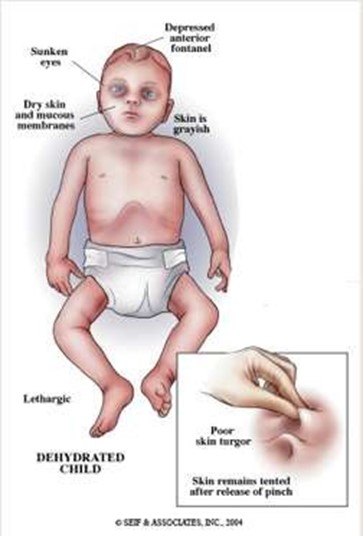A nurse is caring for an infant who has gastroenteritis.
Which of the following assessment findings should the nurse report to the provider?
Sunken fontanels and dry mucous membranes.
Temperature 38° C (100.4° F) and pulse rate 124/min.
Decreased appetite and irritability.
Pale and a 24-hr fluid deficit of 30 mL.
The Correct Answer is A

These are signs of severe dehydration in an infant, which can be life-threatening and should be reported to the provider immediately. The infant may need intravenous fluids and electrolytes to restore hydration and prevent complications.
Choice B is wrong because a temperature of 38° C (100.4° F) and a pulse rate of 124/min are not abnormal for an infant and do not indicate severe dehydration. These are common findings in an infant who has gastroenteritis, which is an inflammation of the stomach and intestines caused by a virus, bacteria, or parasite.
Choice C is wrong because decreased appetite and irritability are also common findings in an infant who has gastroenteritis, but they do not indicate severe dehydration. The nurse should encourage oral rehydration with fluids such as breast milk, formula, or oral electrolyte solution.
Choice D is wrong because pale skin and a 24-hr fluid deficit of 30 mL are not signs of severe dehydration in an infant.
A fluid deficit of 30 mL is less than 1 oz and is not significant for an infant who weighs about 10 kg (22 lbs). A fluid deficit of more than 10% of body weight would indicate severe dehydration.
Normal ranges for vital signs in infants are as follows:
• Temperature: 36.5° C to 37.5° C (97.7° F to 99.5° F)
• Pulse rate: 100 to 160/min
• Respiratory rate: 30 to 60/min
• Blood pressure: 65/41 to 100/50 mm Hg
Normal ranges for fluid intake and output in infants are as follows:
• Fluid intake: 100 to 150 mL/kg/day
• Fluid output: 1 to 2 mL/kg/hr
Nursing Test Bank
Naxlex Comprehensive Predictor Exams
Related Questions
Correct Answer is A
Explanation
Hct stands for hematocrit, which is the percentage of red blood cells (RBCs) in the blood. A client who received 2 units of packed RBCs should have an increased Hct because they have more RBCs in their blood volume.
The normal range for Hct is 38% to 50% for males and 36% to 44% for females.
Choice B is wrong because decreased Hgb means decreased hemoglobin, which is the protein that carries oxygen in the RBCs.
A client who received 2 units of packed RBCs should have an increased Hgb because they have more hemoglobin in their blood. The normal range for Hgb is 13.5 to 17.5 g/dL for males and 12 to 15.5 g/dL for females.
Choice C is wrong because increased platelets means increased thrombocytes, which are the cells that help with blood clotting.
A client who received 2 units of packed RBCs should not have an increased platelet count because they did not receive platelets in the transfusion. The normal range for platelets is 150,000 to 400,000/mm^3.
Choice D is wrong because decreased WBC count means decreased leukocytes, which are the cells that fight infection and inflammation.
A client who received 2 units of packed RBCs should not have a decreased WBC count because they did not receive WBCs in the transfusion. The normal range for WBC count is 4,500 to 11,000/mm^3.
Correct Answer is A
Explanation
Warfarin is a vitamin K antagonist that inhibits the synthesis of factors II, VII, IX, and X in the liver. These factors are part of the extrinsic and common pathways of coagulation, which are measured by the prothrombin time (PT) and the international normalized ratio (INR). The INR is a standardized way of reporting the PT that accounts for the variability of different reagents and instruments. The INR is used to monitor the therapeutic effect of warfarin and to adjust the dose accordingly. The target INR range depends on the indication for warfarin, but it is usually between 2 and 3 for most conditions.
Choice B is wrong because fibrinogen level is not affected by warfarin.
Fibrinogen is a precursor of fibrin, which forms the final step of the coagulation cascade.
Fibrinogen level can be decreased in conditions such as disseminated intravascular coagulation (DIC), liver disease, or severe bleeding.
Choice C is wrong because aPTT is not affected by warfarin.
aPTT measures the intrinsic and common pathways of coagulation, which are mainly dependent on factors VIII, IX, XI, and XII.
These factors are not inhibited by warfarin.
aPTT is used to monitor the effect of heparin, a direct antithrombin agent that inhibits thrombin and factor Xa.
Choice D is wrong because platelet count is not affected by warfarin.
Platelets are cell fragments that adhere to damaged blood vessels and form aggregates to initiate hemostasis.
Platelet count can be decreased in conditions such as immune thrombocytopenia (ITP), heparin-induced thrombocytopenia (HIT), or bone marrow suppression.
Whether you are a student looking to ace your exams or a practicing nurse seeking to enhance your expertise , our nursing education contents will empower you with the confidence and competence to make a difference in the lives of patients and become a respected leader in the healthcare field.
Visit Naxlex, invest in your future and unlock endless possibilities with our unparalleled nursing education contents today
Report Wrong Answer on the Current Question
Do you disagree with the answer? If yes, what is your expected answer? Explain.
Kindly be descriptive with the issue you are facing.
